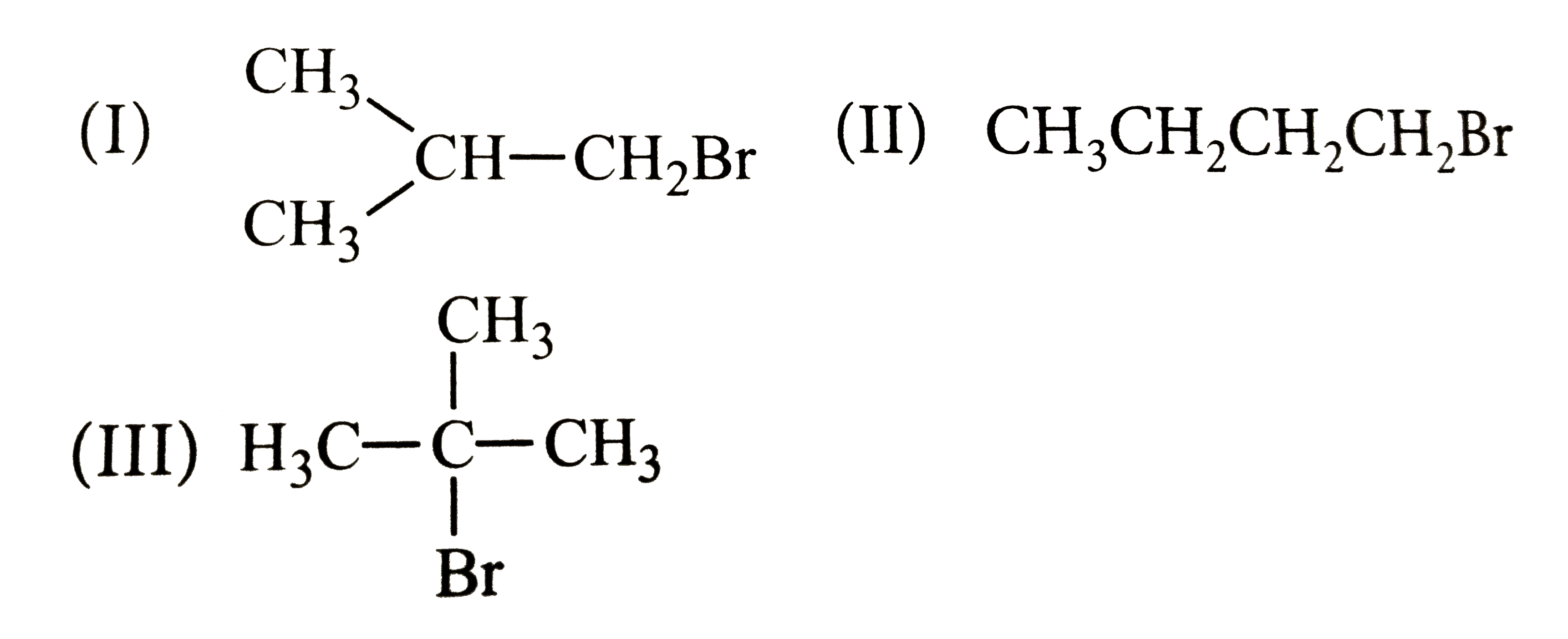Arrange the following in the increasing order of boiling point:
(i) (CH3)3CBr (ii) CHBr∣CHCH2CH3 (iii) CH3CH2CH2CH2Br (iv) (CH3)3C−Cl
To arrange the given haloalkanes in increasing order of boiling point, we need to consider the factors that affect boiling points, such as molecular weight and the degree of branching in the molecules. Here’s a step-by-step solution:
Step 1: Identify the Compounds
The compounds given are:
1. (CH₃)₃CBr (tert-butyl bromide)
2. CH₃BrCH(CH₃)CH₂CH₃ (2-bromobutane)
3. CH₃CH₂CH₂CH₂Br (1-bromobutane)
4. (CH₃)₃Cl (tert-butyl chloride)
Step 2: Analyze the Structure and Branching
- (i) (CH₃)₃CBr: This is a tertiary haloalkane with significant branching. Tertiary haloalkanes generally have lower boiling points due to reduced surface area.
- (ii) CH₃BrCH(CH₃)CH₂CH₃: This is a secondary haloalkane with moderate branching. Secondary haloalkanes have higher boiling points than tertiary ones due to increased surface area.
- (iii) CH₃CH₂CH₂CH₂Br: This is a primary haloalkane with no branching. Primary haloalkanes typically have the highest boiling points among the three types due to maximum surface area.
- (iv) (CH₃)₃C−Cl: This is also a tertiary haloalkane but with chlorine instead of bromine. Chlorine is lighter than bromine, which may affect the boiling point.
Step 3: Compare Molecular Weights
- Bromine (Br) has a higher molecular weight than chlorine (Cl), which generally leads to higher boiling points for brominated compounds compared to chlorinated ones of similar structure.
Step 4: Order the Compounds by Boiling Point
1. Lowest Boiling Point: (CH₃)₃C−Cl - Tertiary structure with chlorine (lower molecular weight).
2. Next Lowest: (CH₃)₃CBr - Tertiary structure with bromine (higher molecular weight than chlorine but still tertiary).
3. Next: CH₃BrCH(CH₃)CH₂CH₃ - Secondary structure with bromine.
4. Highest Boiling Point: CH₃CH₂CH₂CH₂Br - Primary structure with bromine (highest molecular weight and no branching).
Final Order
Thus, the increasing order of boiling points is:
1. (CH₃)₃C−Cl
2. (CH₃)₃CBr
3. CH₃BrCH(CH₃)CH₂CH₃
4. CH₃CH₂CH₂CH₂Br
Summary of the Increasing Order of Boiling Points:
(CH₃)₃C-Cl < (CH₃)₃CBr < CH₃BrCH(CH₃)CH₂CH₃ < CH₃CH₂CH₂CH₂Br
---
The compounds given are:
1. (CH₃)₃CBr (tert-butyl bromide)
2. CH₃BrCH(CH₃)CH₂CH₃ (2-bromobutane)
3. CH₃CH₂CH₂CH₂Br (1-bromobutane)
4. (CH₃)₃Cl (tert-butyl chloride)
- (i) (CH₃)₃CBr: This is a tertiary haloalkane with significant branching. Tertiary haloalkanes generally have lower boiling points due to reduced surface area.
- (ii) CH₃BrCH(CH₃)CH₂CH₃: This is a secondary haloalkane with moderate branching. Secondary haloalkanes have higher boiling points than tertiary ones due to increased surface area.
- (iii) CH₃CH₂CH₂CH₂Br: This is a primary haloalkane with no branching. Primary haloalkanes typically have the highest boiling points among the three types due to maximum surface area.
- (iv) (CH₃)₃C−Cl: This is also a tertiary haloalkane but with chlorine instead of bromine. Chlorine is lighter than bromine, which may affect the boiling point.
- Bromine (Br) has a higher molecular weight than chlorine (Cl), which generally leads to higher boiling points for brominated compounds compared to chlorinated ones of similar structure.
1. Lowest Boiling Point: (CH₃)₃C−Cl - Tertiary structure with chlorine (lower molecular weight).
2. Next Lowest: (CH₃)₃CBr - Tertiary structure with bromine (higher molecular weight than chlorine but still tertiary).
3. Next: CH₃BrCH(CH₃)CH₂CH₃ - Secondary structure with bromine.
4. Highest Boiling Point: CH₃CH₂CH₂CH₂Br - Primary structure with bromine (highest molecular weight and no branching).
Thus, the increasing order of boiling points is:
1. (CH₃)₃C−Cl
2. (CH₃)₃CBr
3. CH₃BrCH(CH₃)CH₂CH₃
4. CH₃CH₂CH₂CH₂Br
(CH₃)₃C-Cl < (CH₃)₃CBr < CH₃BrCH(CH₃)CH₂CH₃ < CH₃CH₂CH₂CH₂Br
Topper's Solved these Questions
- BOOK - MODERN PUBLICATIONCHAPTER - HALOALKANES AND HALOARENESEXERCISE - CONCEPTUAL QUESTIONS25videos
HALOALKANES AND HALOARENES
- BOOK - MODERN PUBLICATIONCHAPTER - HALOALKANES AND HALOARENESEXERCISE - NCERT In-text Questions9videos
HALOALKANES AND HALOARENES
- BOOK - MODERN PUBLICATIONCHAPTER - HALOALKANES AND HALOARENESEXERCISE - UNIT PRACTICE TEST11videos
HALOALKANES AND HALOARENES
- BOOK - MODERN PUBLICATIONCHAPTER - GENERAL PRINCIPLES AND PROCESSES OF ISOLATION OF ELEMENTSEXERCISE - COMPETION FILE (Integer Type Numerical Value Type Questions)5videos
GENERAL PRINCIPLES AND PROCESSES OF ISOLATION OF ELEMENTS
- BOOK - MODERN PUBLICATIONCHAPTER - ORGANIC COMPOUNDS CONTAINING NITROGEN EXERCISE - UNIT PRACTICE TEST5videos
ORGANIC COMPOUNDS CONTAINING NITROGEN
Similar Questions
Knowledge Check
- Question 1 - Select One
Arrange the following compounds in decreasing order of their boiling points
(i) CH3Cl
(ii) CH3CH2Cl
(iii) CH3CH2CH2Cl
(iv) CH3CH2CH2CH2ClA(iii)>(iv)>(i)>(ii)B(iv)>(iii)>(ii)>(i)C(i)>(iii)>(ii)>(iv)D(i)>(ii)>(iii)>(iv) - Question 2 - Select One
Arrange the following compounds in increasing order of their boiling point
(i) (CH3)2CH2CH2−Br (ii) CH3−(CH2)3−Br (iii) (CH3)3C−BrAii lt I lt iiiBI lt ii lt iiiCiii lt I lt iiDiii lt ii lt i - Question 3 - Select One
Arrange the following compounds in the decreasing order of the boiling point:
CH3BrI CH3CH2BrII CH3CH2CH2BrIII
CH3CH2CH2CH2BrAI>II>III>IVBIV>III>II>ICI>III>II>IVDIII>IV>I>II
Arrange the following in increasing order of acid strength :
(i) CH3CH2CH(Br)COOH , (ii) CH3CH(Br)CH2COOH , (iii) CH3COOHView SolutionArrange the following compounds in increasing order of their boiling points.

(ii)CH3CH2CH2CH2Br
H3C−CH3∣C∣Br−CH3View SolutionArrange the following calculations in increasing order of stability and mention order suggested.
(i) CH(+)3
(ii)CH3CH+2
(iii) CH3CH+CH3
(iv) CH3−(+)C∣CH3−CH3View SolutionArrange the following compounds in increasing order of their boiling point
(i)
(ii) CH3CH2CH2CH2Br
(iii) H3C−CH3∣C∣Br−CH3View SolutionArrange the following compounds in increasing order of their boiling points.
 , (ii) CH3CH2CH2CH2Br
, (ii) CH3CH2CH2CH2Br
(iii) H3C−CH3C∣∣Br−CH3View Solution

